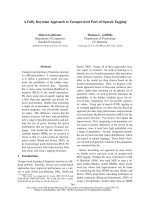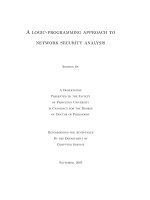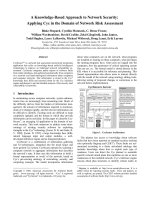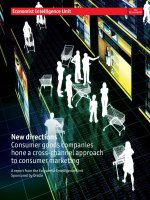Dont make me think revisited:a common sense approach to web usability
Bạn đang xem bản rút gọn của tài liệu. Xem và tải ngay bản đầy đủ của tài liệu tại đây (1.26 MB, 23 trang )
Don’t Make Me Think, Revisited
A COMMON SENSE APPROACH TO WEB USABILITY
Steve Krug
Don’t Make Me Think, Revisited
A Common Sense Approach to Web Usability
Copyright © 2014 Steve Krug
New Riders
www.newriders.com
To report errors, please send a note to
New Riders is an imprint of Peachpit, a division of Pearson Education.
Editor: Elisabeth Bayle
Project Editor: Nancy Davis
Production Editor: Lisa Brazieal
Copy Editor: Barbara Flanagan
Interior Design and Composition: Romney Lange
Illustrations by Mark Matcho and Mimi Heft
Farnham fonts provided by The Font Bureau, Inc. (www.fontbureau.com)
Notice of Rights
All rights reserved. No part of this book may be reproduced or transmitted in any form
by any means, electronic, mechanical, photocopying, recording, or otherwise, without
the prior written permission of the publisher. For information on getting permission for
reprints and excerpts, contact
Notice of Liability
The information in this book is distributed on an “As Is” basis, without warranty. While
every precaution has been taken in the preparation of the book, neither the author
nor Peachpit shall have any liability to any person or entity with respect to any loss or
damage caused or alleged to be caused directly or indirectly by the instructions contained
in this book or by the computer software and hardware products described in it.
Trademarks
It’s not rocket surgery™ is a trademark of Steve Krug.
Many of the designations used by manufacturers and sellers to distinguish their
products are claimed as trademarks. Where those designations appear in this book, and
Peachpit was aware of a trademark claim, the designations appear as requested by the
owner of the trademark. All other product names and services identified throughout
this book are used in editorial fashion only and for the benefit of such companies with no
intention of infringement of the trademark. No such use, or the use of any trade name, is
intended to convey endorsement or other affiliation with this book.
ISBN-13: 978-0-321-96551-6
ISBN-10:0-321-96551-5
987654321
Printed and bound in the United States of America
First Edition
To my father, who always wanted me to write a book,
My mother, who always made me feel like I could,
Melanie, who married me—the greatest
stroke of good fortune of my life,
and my son, Harry, who will surely write books
much better than this one whenever he wants to.
Second Edition
To my big brother, Phil, who was a mensch his whole life.
.
Third Edition
To all the people—from all parts of the world—who have
been so nice about this book for fourteen years.
Your kind words—in person, in email, and in your
blogs—have been one of the great joys of my life.
Especially the woman who said it made her laugh so hard
that milk came out of her nose.
CONTENTS
PREFACE
About this edition
vi
INTRODUCTION Read me first
Throat clearing and disclaimers
2
GUIDING PRINCIPLES
CHAPTER 1
Don’t make me think!
CHAPTER 2
How we really use the Web
CHAPTER 3
Billboard Design 101
CHAPTER 4
Animal, Vegetable, or Mineral?
CHAPTER 5
Omit needless words
10
Krug’s First Law of Usability
20
Scanning, satisficing, and muddling through
28
Designing for scanning, not reading
42
Why users like mindless choices
48
The art of not writing for the Web
THINGS YOU NEED TO GET RIGHT
CHAPTER 6
Street signs and Breadcrumbs
CHAPTER 7
The Big Bang Theory of Web Design
54
Designing navigation
The importance of getting people off on the right foot
[ iv ]
84
CONTENTS
MAKING SURE YOU GOT THEM RIGHT
CHAPTER 8
“The Farmer and the Cowman
Should Be Friends”
Why most arguments about usability are a waste of time, and
how to avoid them
CHAPTER 9
Usability testing on 10 cents a day
102
110
Keeping testing simple—so you do enough of it
LARGER CONCERNS AND OUTSIDE INFLUENCES
CHAPTER 10
Welcome to the 21st Century.
You may experience a slight sense of vertigo
Mobile: It’s not just a city in Alabama anymore
CHAPTER 11
Why your Web site should be a mensch
CHAPTER 12
Just when you think you’re done, a cat floats by
with buttered toast strapped to its back
CHAPTER 13
Making usability happen where you live
Usability as common courtesy
Accessibility and you
Guide for the perplexed
Acknowledgments
Index
[v]
142
164
172
182
192
196
PREFACE
About this
edition
People come and go so quickly here!
—DOROTHY GALE (JUDY GARLAND)
IN THE WIZARD OF OZ (1939)
I
wrote the first edition of Don’t Make Me Think back in 2000.
By 2002, I began to get a few emails a year from readers asking (very politely) if I’d
thought about updating it. Not complaining; just trying to be helpful. “A lot of the
examples are out of date” was the usual comment.
My standard response was to point out that since I wrote it right around the
time the Internet bubble burst, many of the sites I used as examples had already
disappeared by the time it was published. But I didn’t think that made the
examples any less clear.
Finally, in 2006 I had a strong personal incentive to update it.1 But as I reread it
to see what I should change, I just kept thinking “This is all still true.” I really
couldn’t find much of anything that I thought should be changed.
If it was a new edition, though, something had
to be different. So I added three chapters that I
didn’t have time to finish back in 2000, hit the
snooze button, and happily pulled the covers
back over my head for another seven years.
2000
2006
(Writing is really hard for me, and I’m always
happy to have a reason not to do it. Give me a good old root canal over writing
any day.)
So why now, finally, a new edition? Two reasons.
1
Half of the royalties for the book were going to a company that no longer existed, and doing a
new edition meant a new contract—and twice the royalties—for me.
[ vii ]
PREFACE
#1. Let’s face it: It’s old
There’s no doubt about it at this point: It feels dated. After all, it’s thirteen years
old, which is like a hundred years in Internet time. (See? Nobody even says things
like “in Internet time” anymore.)
Most of the Web pages I
used for examples, like
Senator Orrin Hatch’s
campaign site for the
2000 election, look really
old-fashioned now.
Sites these days tend
to look a lot more
sophisticated, as you
might expect.
www.orrinhatch.com 1999
www.orrinhatch.com 2012
Recently I’ve been starting to worry that the book would finally reach a point
where it felt so dated that it would stop being effective. I know it hasn’t happened
yet because
¢It’s
still selling steadily (thank heavens), without any sign of slowing down. It’s
even become required reading in a lot of courses, something I never expected.
¢New
readers from all over
the world continue to
tweet about things they’ve
learned from it.
¢I
still keep hearing this
story: “I gave it to my boss,
hoping he’d finally understand
what I’m talking about. He actually read it, and then he bought it for our whole
team/department/company!” (I love that story.)
[ viii ]
ABOUT THIS EDITION
¢People
keep telling me that they got their job thanks in part to reading it or that
it influenced their choice of a career. 2
But I know that eventually the aging effect is going to keep people from reading
it, for the same reason that it was so hard to get my son to watch black and white
movies when he was young, no matter how good they were.
Clearly, it’s time for new examples.
#2. The world has changed
To say that computers and the Internet and the way we use them have changed
a lot lately is putting it mildly. Very mildly.
2000
2006
2013
iPhone
appears
Last paper
map is used
for directions
Last email
sent by anyone
under 20
Last holdout
on Earth joins
The landscape has changed in three ways:
¢Technology
got its hands on some steroids. In 2000, we were using the
Web on relatively large screens, with a mouse or touchpad and a keyboard.
And we were sitting down, often at a desk, when we did.
Now we use tiny computers that we carry around with us all the time, with
still and video cameras, magical maps that know exactly where we are, and
2
I’m enormously pleased and flattered, but I have to admit there’s always a part of me that’s
thinking “Yikes! I hope she wasn’t meant to be a brain surgeon. What have I done?”
[ ix ]
PREFACE
our entire libraries of books and music built in. And are always connected to
the Internet. Oh, and they’re phones, too.
Heck, I can use my “phone” to
…book a restaurant
reservation in seconds
…adjust the heat in my
house from anywhere
…or deposit a check
without going to an ATM
It’s no flying car (which, come to think of it, we were promised we’d have by
now), but it’s pretty impressive.
¢The
Web itself kept improving. Even when I’m using my desktop computer
to do all the things I’ve always done on the Web (buying stuff, making travel
plans, connecting with friends, reading the news, and settling bar bets), the
sites I use tend to be much more powerful and useful than their predecessors.
We’ve come to expect things like
autosuggest and autocorrect, and we’re
annoyed when we can’t pay a parking
ticket or renew a driver’s license online.
¢Usability
went mainstream. In 2000, not that many people understood the
importance of usability.
Now, thanks in large part to Steve Jobs (and Jonathan Ive), almost everyone
understands that it’s important, even if they’re still not entirely sure what it is.
Except now they usually call it User Experience Design (UXD or just UX),
an umbrella term for any activity or profession that contributes to a better
experience for the user.
[x]
ABOUT THIS EDITION
It’s great that there’s now so much more emphasis on designing for the user, but
all the new job descriptions, subspecialties, and tools that have come along with
this evolution have left a lot of people confused about what they should actually
do about it.
I’ll be talking about all three of these changes throughout the book.
Don’t get me wrong…
This edition has new examples, some new principles, and a few things I’ve learned
along the way, but it’s still the same book, with the same purpose: It’s still a book
about designing great, usable Web sites.
And it’s also still a book about designing anything that people need to interact
with, whether it’s a microwave oven, a mobile app, or an ATM.
The basic principles are the same even if the landscape has changed, because
usability is about people and how they understand and use things, not about
technology. And while technology often changes quickly, people change very
slowly.3
Or as Jakob Nielsen so aptly put it:
The human brain’s capacity doesn’t change from one year to the next, so the
insights from studying human behavior have a very long shelf life. What
was difficult for users twenty years ago continues to be difficult today.
I hope you enjoy the new edition. And don’t forget to wave in a few years when
you pass me in your flying car.
STEVE KRUG
NOVEMBER 2013
3
There’s a wonderful Norwegian video (with subtitles) about
this that shows a monk getting help as he struggles to use the
newfangled “book.” (Search for “medieval helpdesk” on YouTube.)
[ xi ]
4
chapter
Animal,
Vegetable, or
Mineral?
WHY USERS LIKE MINDLESS CHOICES
It doesn’t matter how many times I have to click, as long
as each click is a mindless, unambiguous choice.
—KRUG’S SECOND LAW OF USABILITY
W
eb designers and usability professionals have spent a lot of time over the
years debating how many times you can expect users to click (or tap) to get what
they want without getting too frustrated. Some sites even have design rules stating
that it should never take more than a specified number of clicks (usually three,
four, or five) to get to any page in the site.
On the face of it, “number of clicks to get anywhere” seems like a useful metric.
But over time I’ve come to think that what really counts is not the number of clicks
it takes me to get to what I want (although there are limits), but rather how hard
each click is—the amount of thought required and the amount of uncertainty
about whether I’m making the right choice.
In general, I think it’s safe to say that users don’t mind a lot of clicks as long as
each click is painless and they have continued confidence that they’re on the right track—
following what’s often called the “scent of information.” 1 Links that clearly and
unambiguously identify their target give off a strong scent that assures users that
clicking them will bring them nearer to their “prey.” Ambiguous or poorly worded
links do not.
I think the rule of thumb might be something like “three mindless, unambiguous
clicks equal one click that requires thought.” 2
1
This term comes from Peter Pirolli and Stuart Card’s “information foraging” research
at Xerox PARC in which they drew parallels between people seeking information
(“informavores”) and animals following the scent of their prey.
22 Of course, there are exceptions. For instance, if I’m going to have to drill down through the
same path in a site repeatedly, or if the pages are going to take a long time to load, then the
value of fewer clicks increases.
[ 43 ]
chapter 4
The classic first question in the word game Twenty Questions—“Animal,
vegetable, or mineral?”—is a wonderful example of a mindless choice. As long as
you accept the premise that anything that’s not a plant or an animal—including
things as diverse as pianos, limericks, and cheesecake, for instance—falls under
“mineral,” it requires almost no thought to answer the question correctly.3
Unfortunately, many choices on the Web aren’t as clear.
For example, as recently as a few years ago when I was trying to buy a product
or service to use in my home office (like a printer, for instance), most of the
manufacturers’ sites asked me to make a top-level choice like this:
Which one was me? I had to think about it, and even when I made my choice I
wasn’t very confident it was the right one. In fact, what I had to look forward to
when the target page finally loaded was even more thinking to figure out whether
I was in the right place.
It was the feeling I get when I’m standing in front
of two mailboxes labeled Stamped Mail and Metered
Mail with a business reply card in my hand. What
do they think it is—stamped or metered? And
what happens if I drop it in the wrong box?
3
In case you’ve forgotten the game, there’s an excellent version that you can play against
at www.20q.net. Created by Robin Burgener, it uses a neural net algorithm and plays a
mean game.
[ 44 ]
Animal, Vegetable, or Mineral?
Here’s another example:
I’m trying to read an article online. The page I arrive at gives me all these options:
Now I’ve got to scan all this text and work out whether I’m a subscriber but not
a member, or a member, or neither one. And then I’ll have to dig up the account
number or the password that I used or decide whether it’s worth joining.
At this point, the question I’m asking myself is probably changing from “How
do I answer this question?” to “Just how interested am I in this article?”
[ 45 ]
chapter 4
The New York Times makes the same kind of choice seem much easier by not
confronting you with all the details at once. Making an initial selection (to log in
or to see your options for subscribing) takes you to another screen where you see
only the relevant questions or information for that selection.
This problem of giving the user difficult choices and
questions that are hard to answer happens all the time
in forms. Caroline Jarrett has an entire chapter about
it (“Making Questions Easy to Answer”) in her book
Forms that Work: Designing Web Forms for Usability.
As with Ginny Redish’s book about writing for the Web,
anyone who works on forms should have a well-worn
copy sitting on their desk.
[ 46 ]
Animal, Vegetable, or Mineral?
Some assistance may be required
Life is complicated, though, and some choices really aren’t simple.
When you can’t avoid giving me a difficult choice, you need to go out of your
way to give me as much guidance as I need—but no more.
This guidance works best when it’s
¢Brief:
The smallest amount of information that will help me
¢Timely:
Placed so I encounter it exactly when I need it
¢Unavoidable:
Formatted in a way that ensures that I’ll notice it
Examples are tips adjacent to form fields, “What’s this?” links, and even tool tips.
My favorite example of this kind of
just-in-time guidance is found on street
corners throughout London.
It’s brief (“LOOK RIGHT” and an
arrow pointing right), timely (you see it
at the instant you need to be reminded),
and unavoidable (you almost always
glance down when you’re stepping off
a curb).
I have to think it’s saved the lives of a lot of tourists who expect traffic to be coming
from the other direction. (I know it saved mine once.)
Whether you need to offer some help or not, the point is that we face choices
all the time on the Web and making those choices mindless is one of the most
important things you can do to make a site easy to use.
[ 47 ]
Index
index
$25,000 Pyramid, 36
C
A
Calvin and Hobbes, 153, 191
Camtasia, 122, 163
Cascading Style Sheets (CSS)
and accessibility, 181
earliest use of, 37
and usability, 171
clickability, 15, 37
Collyer, Bud, 85
conventions, 29–33, 64
culture clash, 107
cursor, 37, 152
accessibility, 173–81
affordances, 151–53
Agile development, 4, 118
Animal, Vegetable, or Mineral?, 42–47
Apple, 143
apps, mobile, 155-59
average user, 9
myth of the, 18, 108
B
D–E
Beat the Clock, 85
Big Bang Theory of Web Design, 89
big honking report, 4, 117
Breadcrumbs, 79–80
Brin, Sergey, 26
browse-dominant users, 59
browser
what users say it is, 26
browsing, 60–62
Brundlefly, 162
Burma-Shave, 29
delight, 155–56
designing
conventions and, 29–33
Home page, 84
navigation, 54
and satisficing, 24–25
Web sites, intention vs. reality, 21, 23
do-it-yourself usability testing, 115
Elements of Style, The, 49
expert usability review, 3
[ 197 ]
INDEX
F
I–K
FAQ list, 165, 171
“Farmer and the Cowman Should
Be Friends, The,” 102
Flat design, 152–53
focus groups, 112–13
font size, in browser, 173
forms, 46–47, 67
instructions, eliminating, 51–52
Ive, Jonathan, x, 184
Jarrett, Caroline, 40, 46, 194
Jobs, Steve, x, 184
“kayak” problems, 139
Klein, Gary, 24–25
Kleiner, Art, 107
Krug’s laws of usability, 10–11, 43, 49
G
golden goose, temptation to kill, 99–100
goodwill reservoir, 166–71
H
Hansel and Gretel, 79
happy talk, eliminating, 50
Hatch, Sen. Orrin, Web site, viii
Holmes, Sherlock, 7
Home page
cluttered, 39
designing, 84
happy talk on, 50
link to, 70
hover, 152
L
Larson, Gary, 23
Lean startup, 4, 114
Lincoln, Abraham, 145
link-dominant users, 59
links, visited vs. unvisited, 190
logo. See Site ID
M
memorability, 159
mensch, 164
mindless choices, 42–47
mirroring, 161
mission statement, 95
mobile
apps, 155
usability testing, 160
Mobile First, 147–49
muddling through, 25–27
[ 198 ]
index
N
R
names, importance of, 14
navigation
conventions, 64
designing, 58
lower-level, 72
persistent, 66
revealing content, 63
needless words, omitting, 48–52
new feature requests, 139
Nielsen, Jakob, xi, 54, 58–59, 96, 115, 121
noise. See visual noise
Norman, Don, 151
recruiting test participants, 120–21
Redish, Janice (Ginny), 40, 41, 46, 179, 194
registration, 87, 99
reinventing the wheel, 31
religious debates, 103, 104, 109
reservoir of goodwill, 166–71
responsive design, 149, 150
“right” way to design Web sites, 7
Rosenfeld, Louis, 194
P
page name
importance of, 74–76
matching what user clicked, 76
position on page, 75
persistent navigation, 66
primary navigation. See Sections
Prince and the Pauper, The, 26
printer-friendly pages, 171
promos
content promos, 86
feature promos, 86
pull-down menus, limitations of, 108–09
[ 199 ]
S
satisficing, 24–25
scanning pages, 22–23
scent of information, 43,
script for usability test, 125, 127–36
search box, 16–17, 30, 58, 71–72, 86, 99
on Home page, 86
options, 71
wording, 71
search-dominant users, 58
secondary navigation. See subsections
section fronts, 50
Sections, 69–70
signifiers, 151
Site ID, 67–68
sizzle, 169
slow-loading pages, 59
stop signs, 29
INDEX
street signs, 64, 74
subsections, 68–69
unmoderated, 140
value of starting early, 115
what to test, 124
User Experience Design (UXD, UX), x, 183
UserTesting.com, 140
Utilities, 65, 69–70
T
tabs, 80–81
color coding, 81
importance of drawing correctly, 81
tagline, 93, 95–98
Talking Heads, 55
teleportation, 62, 67, 92
Theofanos, Mary, 179
tradeoffs, 145–47
tragedy of the commons, 100
trunk test, 82–83
V–Z
validator, accessibility, 177
visual hierarchy, 33–36
visual noise, 38
Welcome blurb, 93
White, E. B., 49
xkcd, 194
Zuckerberg, Mark, 26
U
usability
attributes of, 155
defined, 9
usability lab, 115
usability testing, 3, 110
do-it-yourself, 115
vs. focus groups, 112–13
of mobile devices, 160–63
number of users to test, 119
observers, 124
recruiting participants, 120–21
remote, 140
reviewing results, 137–39
sample session, 127
[ 200 ]









